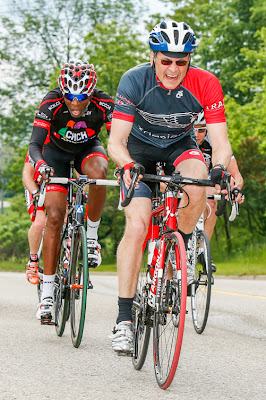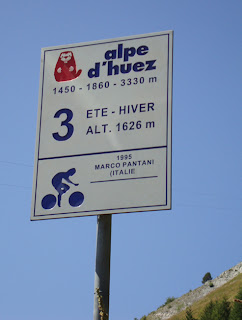Ten Lessons from Race #1
The best thing about my first race is I never have to go through the experience of my first race ever again.
Not that it wasn't fun; it was, in a wow-I-can't-believe-I-actually-did-that kinda way. It was also confusing, nerve-wracking, frightening, humbling, and a very good learning experience. Inevitably I screwed some things up; I assumed I would. (My first triathlon 20 years ago must have set some kind of record for dumb newbie mistakes, so I figured there would be some of that here too.)
The good news of course is: next time it will be better.
Here then is a list of 10 lessons I took out of Race Number 1:
1. Know the course. If you haven't actually ridden it, give thanks for Google Maps. I used Street View to familiarize myself with the course and even though I hadn't ridden it before, it was all completely familiar & there were no real surprises. Except how the hills actually felt. You can't really get a feel for gradients from Street View. (MapMyRide.com is good for elevations.)
2. Warm up a lot – leave time to get in at least 25 minutes -- and include sprints & climbs if possible. Especially if it's a relatively short race. The start might be brutally fast, and you need to be in mid-ride form so you can hit it hard right away. In my race, a good half the field got dropped in the first few laps and could never bridge back on.
3. Check your bike thoroughly before you line up. The first time I needed to touch my front brake there was nothing there & I realized that I had left the release lever open when I put my front wheel on. Panic! (And really – not a good place to panic.) I had to gingerly feel my way down the head tube to the fork, not daring to look down as I was still in the pack and doing about 40 kph, and flip the lever and pray I didn't put my hand into the spokes.
4. Get to the line early. I screwed up a couple of equipment things (left on my knee warmers, forgot one glove) and the trips back to the car meant I was one of the last riders to the line. Starting that far back just meant I got dropped sooner. I might have held on a lot longer if I had been farther up and more protected.
5. Hang tough. That painful, burning sensation in your lungs and legs gets surprisingly manageable after 25 or 30 km. Train for lactate threshold.
6. Talk to people. Make alliances. When you get dropped, look for other riders to team up with on a paceline. Even if finishing with the peloton is out of the question, everybody still wants to improve their time and placing. And it really helps.
7. Be a meteorologist. If there is wind, Know which way it's blowing across the course. The start in my race had long straightaway with a tailwind which was part of the reason it went off so fast. And I knew there would be wind on the uphill portions of the course so it was not unexpected. It might have been very discouraging otherwise. If the forecast calls for rain, wear your shoe covers. A hard rain hit in the middle of the race and quickly soaked my shoes, after which they weighed about 5 pounds each.
8. Bring a towel. You'll need it, or your bike will need it, or both. For something. Guaranteed.
9. Stick around afterwards for the podium presentations. It's cool to see who won, and personally I think it's sportsmanlike to acknowledge the winners. And it never hurts to visualize yourself up there some day.
10. Pack good post-ride food. You need protein, carbs, and a sense of reward, as soon as possible after you get off the bike. Make it something really good.
And just in the realm of aesthetics, yes, shave the legs. (I felt I had to race once before I did it.) One shouldn't look like a hippie douche going to a Critical Mass ride. And maybe wear contacts and decent shades, rather than goofy-looking wire-framed prescription sunglasses. And OK, that helmet may have to go, too.
Just sayin'.
Not that it wasn't fun; it was, in a wow-I-can't-believe-I-actually-did-that kinda way. It was also confusing, nerve-wracking, frightening, humbling, and a very good learning experience. Inevitably I screwed some things up; I assumed I would. (My first triathlon 20 years ago must have set some kind of record for dumb newbie mistakes, so I figured there would be some of that here too.)
The good news of course is: next time it will be better.
Here then is a list of 10 lessons I took out of Race Number 1:
 | ||
| What was I thinking with those socks? |
1. Know the course. If you haven't actually ridden it, give thanks for Google Maps. I used Street View to familiarize myself with the course and even though I hadn't ridden it before, it was all completely familiar & there were no real surprises. Except how the hills actually felt. You can't really get a feel for gradients from Street View. (MapMyRide.com is good for elevations.)
2. Warm up a lot – leave time to get in at least 25 minutes -- and include sprints & climbs if possible. Especially if it's a relatively short race. The start might be brutally fast, and you need to be in mid-ride form so you can hit it hard right away. In my race, a good half the field got dropped in the first few laps and could never bridge back on.
3. Check your bike thoroughly before you line up. The first time I needed to touch my front brake there was nothing there & I realized that I had left the release lever open when I put my front wheel on. Panic! (And really – not a good place to panic.) I had to gingerly feel my way down the head tube to the fork, not daring to look down as I was still in the pack and doing about 40 kph, and flip the lever and pray I didn't put my hand into the spokes.
4. Get to the line early. I screwed up a couple of equipment things (left on my knee warmers, forgot one glove) and the trips back to the car meant I was one of the last riders to the line. Starting that far back just meant I got dropped sooner. I might have held on a lot longer if I had been farther up and more protected.
5. Hang tough. That painful, burning sensation in your lungs and legs gets surprisingly manageable after 25 or 30 km. Train for lactate threshold.
6. Talk to people. Make alliances. When you get dropped, look for other riders to team up with on a paceline. Even if finishing with the peloton is out of the question, everybody still wants to improve their time and placing. And it really helps.
7. Be a meteorologist. If there is wind, Know which way it's blowing across the course. The start in my race had long straightaway with a tailwind which was part of the reason it went off so fast. And I knew there would be wind on the uphill portions of the course so it was not unexpected. It might have been very discouraging otherwise. If the forecast calls for rain, wear your shoe covers. A hard rain hit in the middle of the race and quickly soaked my shoes, after which they weighed about 5 pounds each.
8. Bring a towel. You'll need it, or your bike will need it, or both. For something. Guaranteed.
9. Stick around afterwards for the podium presentations. It's cool to see who won, and personally I think it's sportsmanlike to acknowledge the winners. And it never hurts to visualize yourself up there some day.
10. Pack good post-ride food. You need protein, carbs, and a sense of reward, as soon as possible after you get off the bike. Make it something really good.
And just in the realm of aesthetics, yes, shave the legs. (I felt I had to race once before I did it.) One shouldn't look like a hippie douche going to a Critical Mass ride. And maybe wear contacts and decent shades, rather than goofy-looking wire-framed prescription sunglasses. And OK, that helmet may have to go, too.
Just sayin'.

Comments
Post a Comment